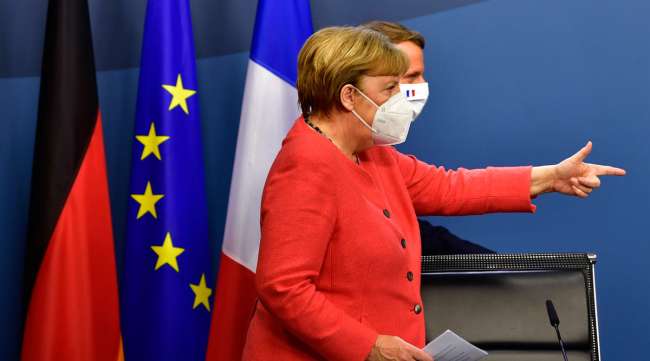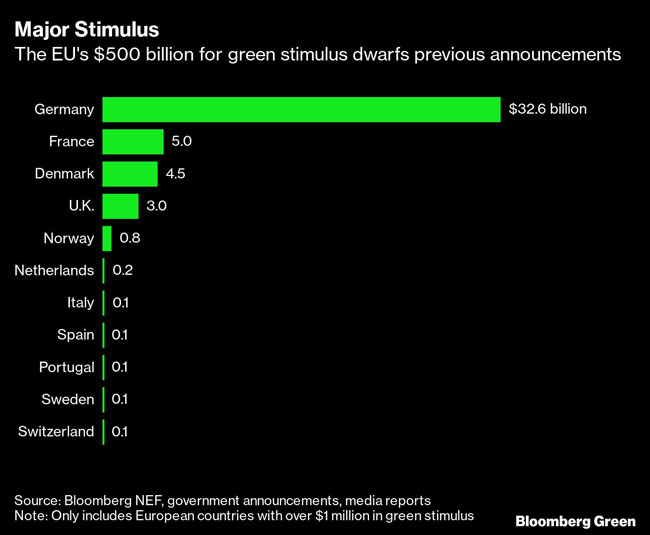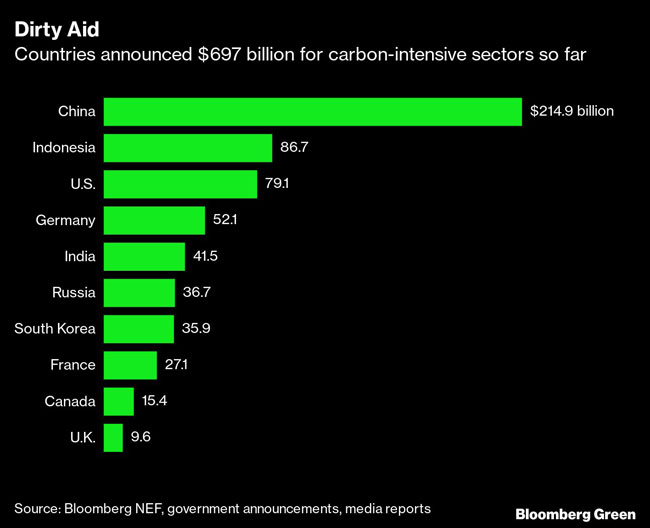Bloomberg News
EU Approves Biggest Green Stimulus in History

[Ensure you have all the info you need in these unprecedented times. Subscribe now.]
European governments approved the most ambitious climate change plan to date, agreeing to pour more than €500 billion euros ($559.5 billion) into everything from electric cars to renewable energy and agriculture.
At a five-day summit in Brussels, heads of government reached a deal on an unprecedented economic rescue plan and seven-year budget for the region worth €1.8 trillion euros ($2 trillion). Almost a third of that is earmarked for climate action, offering the bloc’s 27 nations a chance to develop clean energy resources, stimulate the market for emission-free cars, invest in budding technologies and promote energy efficiency.
“Never before, has so much of an EU budget been allocated to combating climate change,” German Environment Minister Svenja Schulze said. “The commitments to climate action and environmental protection are important and necessary, but the distribution of funds must reflect that.”

The plan is part of Europe’s bid to become the world’s first climate-neutral continent by 2050, putting it ahead of other major emitters such as the U.S., China, and India in the global fight against unstoppable temperature rise. The proportion of the European package earmarked for climate projects illustrates that contrast dramatically.
Only $54 billion of the trillions of dollars of recovery funds pledged globally will be channeled into green policies, while $697 billion has been allocated for carbon-intensive sectors such as air travel and fossil fuel extraction, according to a Bloomberg report released prior to the EU’s stimulus deal.
Germany’s recovery plans are among the greenest so far, with about a third of the 130 billion euros ($145 billion) recovery budget going into areas such as public transport and development of green hydrogen. Significantly, for a country where car manufacturing represents a significant part of the economy, no funds were directed toward fossil fuel cars. Subsidies to buy electric vehicles in Germany are so generous that some Renault models can be acquired for free.
The U.K.’s plan has fallen short of previous climate-related promises and is far behind its European neighbors’. The country has so far announced 5.4 billion euros ($6.8 billion) in measures such as boosting green homes and supporting carbon-capture technology. China will invest 10 billion yuan ($1.4 billion) in electric vehicle chargers and support new renewable energy plants, though it has also cleared the way for new coal projects.
None of the $3.6 trillion in stimulus approved by the U.S. so far specifically targets low-carbon parts of the economy. In April, President Donald Trump’s administration issued a rule that weakened carbon dioxide emission caps. Negotiations are underway in Congress to deliver further stimulus, but that’s unlikely to contain green provisions.

Transport Topics introduces its newest digital interview series, Newsmakers, aimed at helping leaders in trucking and freight transportation navigate turbulent times. Audience members will gain access to the industry's leading expert in their particular field and the thoughtful moderation of a Transport Topics journalist. Our second episode — "The Evolution of Electric Trucks" — featuring Nikola founder and executive chairman Trevor Milton, will air live on July 28 at noon EDT. Registration is free but advance signup is required. Sign up today.
“There is no doubt this is the world’s greenest stimulus plan,” said Simone Tagliapietra, a researcher at Bruegel, a Brussels-based economic think tank. “Member states should now put forward sensible green national recovery plans, prioritizing those policies that have a triple dividend: economic growth, greening, equity.”
The EU’s ambitious Green Deal will require hundreds of billion of euros of annual investment. The environmental clean-up is already under way. The European Commission, the EU’s executive arm, is considering raising its 2030 emission-reduction target to as much as 55% from its current 40%, a move that would affect every sector of the economy from energy to agriculture and trade. Under the deal struck early July 21, the objective will be revised by the end of this year.
The deal didn’t come easy, and talks came close to collapse at several points because of clashing national interests. But the fact that there was little or no controversy around raising the budget’s target on climate from an initial 25% to 30%, or that it included a clause in which EU members commit to do no harm to climate goals, shows how far EU governments and their voters have gone in embracing climate policies.
“There’s no getting around the fact that climate now has an essential role in EU politics,” said Johanna Lehne, a policy adviser at E3G, a Brussels climate think tank. “There are caveats on how it will be put to practice, but that’s still a massive investment in a better recovery.”

Other green provisions of the EU stimulus deal include:
- The rescue fund and the 2021-27 budget must comply with the EU goal of climate neutrality and contribute to the new 2030 emission target.
- The European Investment Bank will become the EU’s climate bank; its board will review a capital increase by the end of this year.
- To make farming more sustainable, 40% of the EU’s agriculture budget will be dedicated to climate.
- The commission will develop a methodology for monitoring climate spending to detect and prevent greenwashing, and will report annually on green expenditure.
In a final compromise, the €750 billion euro ($858 billion) rescue fund contained fewer grants and more low-interest loans, impacting the size of some investment programs in areas such as health and climate. The Just Transition Fund, a tool to help the most affected regions bear the costs of the green transition, was slashed to €17.5 billion euros from €40 billion euros ($46 billion).
To see climate going from being named a top priority for EU leaders to “a pawn in the bigger negotiation” was striking, Lehne said. “It bears raising the question of where the leadership is on climate and whether leaders are living up to their own calls for a green recovery.”
“This agreement is at the expense of the climate,” said Michael Bloss, a German member of the Greens group in the European Parliament.
Want more news? Listen to today's daily briefing:
Subscribe: Apple Podcasts | Spotify | Amazon Alexa | Google Assistant | More



